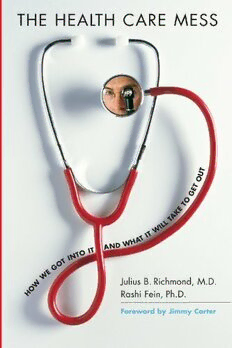
The Health Care Mess: How We Got Into It and What It Will Take To Get Out PDF
320 Pages·2007·2.454 MB·English
Most books are stored in the elastic cloud where traffic is expensive. For this reason, we have a limit on daily download.
Preview The Health Care Mess: How We Got Into It and What It Will Take To Get Out
Description:
In reading the previous reviews, I must say that they are quite accurate in many of their findings - the style of writing tends to be verbose and there isn't much in the ways of "how to do fix the US health care system." But that is not what this manuscript is about.
Let me quickly rebut a few points from each of the previous reviews.
From Mr. Weston: " When I bought the book, I was hoping the authors' would answer the question "What is equitable health care?" Is it equitable for the government to pay for medications that control blood pressure, insulin response, and bone density when all of these could be managed by diet and exercise? Americans have a problem giving welfare to those who can work. Why give "healthfare" to those who can diet and exercise? "
First of all, equity is in the eye of the beholder. This is an area where even the most brilliant health economist cannot give a true answer. Our basis for equity depends upon our own moral upbringing.
Secondly, it is obvious from the latter half of his comment that he does not have anything to do with the health care delivery system. Lifestyle modifications for hypertension, diabetes, and osteopenia/osteoporosis, while certainly beneficial, are not effective to the degree needed to prevent stroke, heart attack, or hip fractures. However, I will concede that doctors often over-utilize healthcare resources of limited benefit.
Moving on to Ms. Clendenen's excellent review:
" The three that immediately come to mind are the complete neglect in discussing the impact that the cost of pharmaceuticals has had on the overall cost of health care, the impact that malpractice litigation and the threat of malpractice suits have had, and the incredible cost of the administrative labyrinths that exist for most providers. "
It would appear that for her, a serious health economist, this book misses the mark. There, however, is a brief discussion of malpractice litigation in Chapter 7. I believe the authors spent considerably less time on this subject than on the subjects of medical education and "orgranized medicine" because malpractice litigation appears to have limited effect on total national health expenditures (estimated to be about 1/2 of 1%).
I agree with her that this book does little to explain the impact of administrative complexities on physicians. I can firmly attest that I spend far too much time doing paperwork than seeing patients. However, in the concluding chapter, the authors suggest a system - albeit a system closer to the single-payer edge of the political spectrum - that naturally would result in less administrative hassles for everyone involved compared to our current "nonsystem".
And now onto Ms. Craig: Her thoughtful review begins to introduce the concept, not discussed in this book, that a small percentage of patients represent the largest percentage of medical expenditures. She also refers to ICU stays - where I have witnessed survival rates less than 30% - that account for a tremendous fraction of our health care dollar. As a nation we do spend too much money on care in the last 6 months of life. Unfortunately, we often times cannot tell when someone will die. Additionally, even when death is virtually around the corner (by that I mean, when there is no chance for a "meaningful" life) we have families who want doctors to keep their loved ones "alive" for extended periods of time. As a nation, our culture of life may be in opposition to our appropriate use of health care resources.
Okay, enough of the rebuttals (I only do it because I liked this book). I believe the point of "The Health Care Mess" is to introduce the layman to the history of the American healthcare system. It does this while addressing issues relevant to physicians - medical education and the American Medical Association's persistent interference with progressive health reform. I believe this book may not be best geared towards the practicing health economist or the policy maker. "The Health Care Mess" is best designed for motivating a sleeping constuency - medical professionals and medical students. These folks are far too overburdened with their work to realize that they also need to be involved in the health care debate. Perhaps that is why the authors suggest making our current disorganized health care system focus attention on the academic medical centers as "hubs" for healthcare.
You will not find answers in this book. But you will find that political stumbling blocks are typically the reasons why most recommendations to modify our current system have failed. It is the politics, not the science, that is important in changing health policy. This is where the focus lies in "The Health Care Mess."
See more
The list of books you might like
Most books are stored in the elastic cloud where traffic is expensive. For this reason, we have a limit on daily download.
